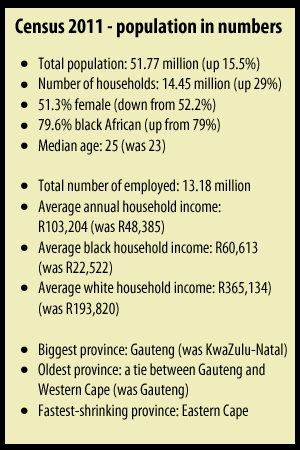Census 2011 paints a rosy picture of a country better off than it was 10 years ago by every measure - except for the number of vulnerable children.
South Africa is a fuller place than it was in 2011. It is also considerably better off than it was in 2001 – no matter how you slice it – with more money, better access to services and a higher level of education. The one exception is the number of orphans.
The improvements, in broad strokes at least, are clearly painted by initial data released on Tuesday by Statistics South Africa (Stats SA) for South Africa's first full count in a decade, again reinforcing that widespread service delivery protests are a function of relative inequality and dashed expectations rather than worsening conditions.
On the night of October 9 2011, there were 51 770 560 people in South Africa, an increase of 15.5% from 2001 (and a headache in the making for the 49M electricity-saving campaign, which is based on a population of 49-million).
Of those, 51.3% were female, which is a slightly smaller proportion than a decade before, and 79.6% were black African, which is slightly up from 2001.
The country was somewhat older than in 2001, with a median age of 25, compared to 23 for the last census. People were, on average, older across every province and racial group, except black people, who grew a collective one year younger with a median of 21.
In 2001 a total of 17.9% of people at least 20-years-old had reported no schooling, in Census 2011, that had shrunk to 8.6%. The proportion of those who had completed matric and had some higher education also rose sharply and children who weren't in school or were leaving school early were considerably rarer.

Average household income in 2011 stood at R103 204 per year, more than double that reported 10 years before. Female-headed households were still bringing home much less than those with men in charge, a little more than half, but had gone some way towards closing the gap with faster growth. The income reported by white people grew faster – considerably faster – than that of any other racial group, and white households were bringing in more than six times the average income of their black equivalents.
Though the income numbers would seem to indicate higher employment, an actual comparison with 2001 is tricky. The way unemployment is measured and data collected has changed over the period, and the census data deviates sharply even from labour force surveys conducted in 2011. But despite the effects of global recession felt in 2011 (compared to much healthier economic conditions in 2001), more people seemed to have some form of remunerative work.
The sharpest difference – and greatest improvement in living standards – is in access to basic services. In the 2011 census, 73.4% of South Africans reported having access to piped water insider their homes or yards. 60.1% said they had flush toilets and 84.7% were using electricity for lighting. Refuse was removed by a local authority at least once a week for 62.1% of the population.
Where the news was bad, though, it was really bad. Among children under the age of 18, the data shows 3.7% were orphans, nearly double the proportion in 2001. A full 22.8% of children had lost either a father or a mother, leaving 3.37-million orphans, or about one orphan for every 15 people in the country.
"These estimates provide an indication of the number of children who are vulnerable, and the consequent policy implications," Stats SA said in its initial overview.